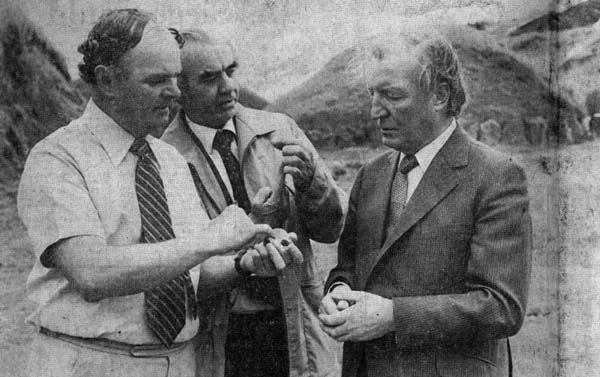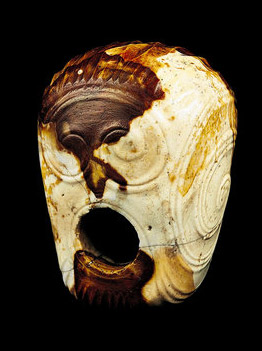Neolithic Artefact Found at Knowth
Irish Times Reporter - September 1982
George Eogan (left), of UCD, Breandán Ó Ríordáin, director of the National Museum, and the Taoiseach, Mr Haughey at the Knowth tomb
The discovery of a "highly significant" artefact at Knowth in the Boyne Valley, where excavation under George Eogan have been underway for over 20 years, was announced when the Taoiseach, Mr. Haughey, visited the site yesterday afternoon.
Mr Haughey was greeted by Dr. Eogan and the director of the National Museum, Breandán Ó Ríordáin, and was introduced to Mr. Liam O'Connor, the site worker who found the object.
Described by Dr. Eogan as "a major work of art, reflecting the individuality of the original craftsman" and "the only one of its kind, and of particular significance in its early context," the object is carbon-dated as around 5,000 years old and loosely termed a mace-head, since it was carried upon the end of a stick by means of the hole through its centre.
Mistaken for a Shell
The mace-head was found last week by Mr. O'Connor of Sheepsgrange during a routine shifting of first-level stones inside the big eastern passage grave at Knowth. At just over three inches long, it is a cylindrical piece of brown and white flint, at first mistaken for a shell by its discoverer.Looked at closely, its carefully worked carvings emerge as two sides ornamented by triple-ridge spirals, a side holding a shallow 'U' shape and a fourth side resembling a human face, smiling broadly. The top and bottom are sculpted with diamond-shaped facets, and the instrument used was a stone even harder than flint itself in all probability crystal.
For fifty centuries the mace-head has lain inside the northernmost recess of the Stone Age grave, whose length is 135 feet. Its cross shaped main chamber has a 20-foot high corbelled roof and its area is an acre and a half, making it one of Europe's largest public monuments of the Neolithic era. It also has decorated orthostats in its walls and it was in this largest of the three recesses that Dr. Eogan and his workers found the large and ornate stone basin that is their other main find. But the mace-head is considered more valuable.
"In its own way it's another Tara Brooch," commented Dr Ó Ríordáin, and Dr. Eogan added that its craftwork made it a forerunner of the much later Tara brooch, using spirals and pelta-shaped whorls in ridges.
"Any one of these big, decorated stones would justify two or three years' work for you and now you've found 90 major artefacts," the Taoiseach told Dr. Eogan. Funding for Knowth where digging began in 1962 has been virtually open-ended, conceded Dr. Eogan, and administered through the Office of Public Works (Parks and Monuments) on the recommendation of the National Committee for, Archaeology of the Royal Irish Academy.

"Only now are we dimly beginning to grasp the importance of all these finds," commented Mr Haughey to Dr Eogan, "and now that people are forever, talking about their roots, this sort of thing reminds us of 5,000 years of our continuity.
Pressed about future funding for Knowth and other museum projects the Taoiseach said: "(It's always difficult to get money for the public sector, but we'll always set some aside for a priority. I would call our heritage a priority.
He expected the National Heritage Council Bill to run straight through the Dail and the Seanad during this session and ensure security of funding for future projects.
The mace-head will go on view in the National Museum, Kildare Street, Dublin, from next Tuesday.
Boyne Valley Private Day Tour
 Immerse yourself in the rich heritage and culture of the Boyne Valley with our full-day private tours.
Visit Newgrange World Heritage site, explore the Hill of Slane, where Saint Patrick famously lit the Paschal fire.
Discover the Hill of Tara, the ancient seat of power for the High Kings of Ireland.
Book Now
Immerse yourself in the rich heritage and culture of the Boyne Valley with our full-day private tours.
Visit Newgrange World Heritage site, explore the Hill of Slane, where Saint Patrick famously lit the Paschal fire.
Discover the Hill of Tara, the ancient seat of power for the High Kings of Ireland.
Book Now
Home
| Visitor Centre
| Tours
| Winter Solstice
| Solstice Lottery
| Images
| Local Area
| News
| Knowth
| Dowth
| Articles
| Art
| Books
| Directions
| Accommodation
| Contact

